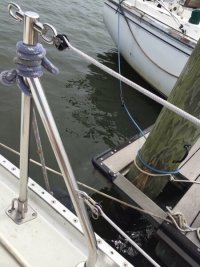OK, I'll bite.
I replaced my lifelines with dyneema this spring, but that's nowhere near as critical as shrouds.
I'd say that deciding whether or not to use dyneema (pretensioned to avoid the stretch you'll get with regular dyneema) will be influenced heavily by these considerations:
- how big is the boat? (can you really save a lot of $ with dyneema over time compared to wire?)
- what is the main use of the boat (racing? day/weekend sailing? short-term coastal and Caribbean cruising? bluewater cruising?)
- how confident are you in your ability to splice dyneema, and how will you tension the rig?
- how will you measure the rig tension?
- are you factoring into your hassle and cost calculation that dyneema should be replaced every ~5 years? (compared to wire, which is at least 10 years, and longer if not in salt water, and even longer if little used and not ridden hard).
19x1 ss wire is still SOP for bluewater cruisers, but they often take a spool of dyneema with them to replace standing rigging elements that are found to be suspect mid-passage, and for jury rigging if necessary
19x1 wire is still the choice of most coastal cruisers because it lasts a really long time
But when you get into racing and day sailing, where you will check your rig each outing and you can bail and make repairs at short notice if needed, dyneema would be a consideration (for the DIY aspect for daysailing and for weight reduction for racing)
I don't know how to measure dyneema tensions - I think traditional Loos gauges only work on wire.
DIY vs professional service: A lot of cruisers have gone to DIY StayLok style non-permanent 'swage ends', so they can make new stays themselves when they're a long way from professional swaging machines. You might save about 15-20% on total cost if you use these and DIY instead of getting a rigger to make new shrouds for you.
Point of reference for cost: This spring, I had West Marine replace all my standing rigging, except my forestay. In addition to new wire and swaged ends, I also got all new turnbuckles. The total cost was a little under $3k. I avoided all shipping costs (old wires --> WM as the templates, and new stays back to me, with the old wires) by sending out and receiving back via my local WM store. Their WM rigging shop in Rock Hill SC was very very helpful and communicative.
The good thing about replacing standing rigging is you can do it in stages, to spread out the cost, if you want. I did mine with my mast up, so I had to do it one pair of stays at a time.
Good luck with your project!








